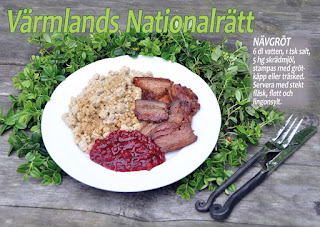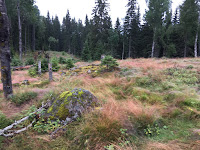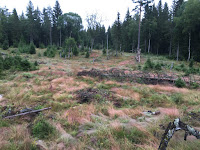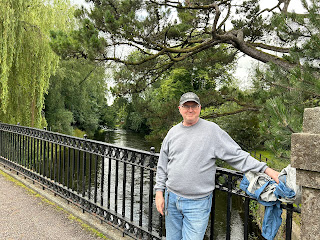We told her that we were traveling to Sweden to see first-hand what it was like. “Where are you going to go?”, she asked. Well, first, we'll spend a week in Stockholm. She nodded and smiled, “It's so beautiful there.” Then we're going to travel west to spend a week in Västerås. ”Oh, I was born in Västerås, you'll love it.” And then we're going to continue west to spend a week in Värmland. That's when it first happened.
A look of confusion mixed with a touch of concern played across her face. “Ah, Värmland... but what will you do?”
This same scene repeated itself when we chatted with the hotel clerk in Stockholm. Then again with a charming woman in a shop in Gamla Stan. And with the hotel clerk Jonas when we got to Västerås. Jonas gave us that look of sincere concern: “What will you do? Don't get me wrong, I'm from Dalarna and it's beautiful in Värmland.” (Dalarna is the county/län north of Värmland, famous for its copper mines and wooden horses.) Somehow, it felt that while no one was willing to directly say anything negative, the idea that Värmland was a place that an American would want to go was deeply confusing.
So, why Värmland? Well, this is the part of the country where my great grandmother, Johanna Barthelsson, came from. As I described in an earlier post, these were Forest Finn people, emigrants who came to Sweden in the mid-1600s to settle the wild border regions. Unlike our earlier stops, there was no big city like Västerås or Stockholm to use as our base of operations, at least not without adding at least a good hour's drive. So I decided to work out of the town of Torsby.
Torsby is a very modest town. The old name of the parish there is Fryksände, which translates as the “end” (“-ände”) of the Fryken. The Fryken is a long narrow lake, or more precisely a series of three lakes. They look a lot like the Finger Lakes in New York, but on a smaller scale. Fryken extends for 80 km, or 50 miles from the town of Kil (pronounced “sheel”) in the south to Torsby in the north. There's not a whole lot of choices when it comes to hotels in Torsby. We stayed at a very lovely place called the Hotel Örnen, or the Eagle Hotel, the former house of a town doctor, now run something like a cross between a standard hotel and a bed-and-breakfast. It's very pretty, convenient, and friendly place to stay.
My plan, such as it was, was simply to visit the towns, parishes and settlements that I'd seen in all of the old church documents I'd been using to trace family history. We also planned to get together with a cousin that I had met over the Internet, Ann Meyer Nordström. Beyond that, nothing specific other than to “absorb” the countryside.
The drive from Västerås to Torsby was roughly 3 hours or so. The first thing to do, of course, was to explore Torsby and the Fryksände church and grounds. I swear that you could walk from one end of Torsby to the other in a half hour, so it wasn't hard to get around. Most of my family didn't live in Torsby per se, but in the small towns and settlements scattered around it, mostly to the north and northwest. There's enough going on in and around the town, though, that it was very comfortable. For example, there's a year-round ski tunnel just outside of town. Now I don't ski, so I can't tell you if it's good or bad. But the idea of a tunnel carved out of – no, into - the hillside where you can ski winter and summer (mostly summer, I'd guess) is pretty impressive. That level of activity also means that there are a fair number of restaurants in the area: we really liked a little hole-in-wall Japanese place where we struck up a brief acquaintance with the hostess. Sushi in Värmland: the world has changed, hasn't it?
My next objective to explore was the parish of Östmark. This was a drive of about 24 km (a little less than 15 miles) northwest of Torsby. This is a tiny town: the census in 2010 listed a grand total of 216 residents! From my point of view there were two main attractions: there's the Emigration and History Research Center and the parish church. I really didn't want to use the little time we had in Sweden sitting inside in a library – although it killed me to pass up the opportunity. So we'll have to leave a serious visit to the Center for a future trip (hint, hint; nudge, nudge). The Östmark church, however, was amazing.
First off, remember that we'd come from the big cities and the parishes immediately surrounding them. The churches there are good, solid, stone and masonry buildings. That's what was so striking about Östmark: the church is made of wood! It's as big (or nearly so) as the local churches we'd seen around Västerås, but much more rustic. Its sides are shingled and stained a deep red-brown color. It was built in the 1760s, so certainly some of my ancestors had a hand (or a kronor) in its construction.
Like all of these churches there's a graveyard on the property. We found that these cemeteries usually had pretty recent graves, that is, generally less than 150 years old. (Recycling, if you know what I mean.) In most churchyards, at least in my limited experience, I'm used to seeing the individual graves marked by headstones. Some are very modest, and some quite extravagant. In many place, I know, the scarcity of stones forced people to mark graves with wooden crosses. These, generally, can't withstand the elements, and so old wooden markers are pretty uncommon. But in Värmland, we commonly saw another type of marker. It's made of wrought iron, with a single vertical shaft and several horizontal crossbars. Sometimes you'll see little iron “leaves” hanging off the crossbars, so perhaps it's both a cross and symbolic for a tree. Then, often, there's a small, flat iron plate upon which is inscribed the name(s) of the persons being commemorated. Maybe – originally – the names are always there, but today it's not uncommon that there is no name plate.
To recap, we've just arrived at the church in Östmark, and I'm starting to wander around a bit just to get oriented. Almost the very first of those iron markers I looked at put me nearly in a state of shock. Right next to the church itself is a marker, and on the name plate you can clearly read: “Här viler tväne goda makar Hindrik Hindrikson på Kronskogen föd 1802 och hustrun Maria Bengtsdotter föd 1799.” This translates to “Here lie the two good spouses, Hindrik Hindrikson of the Crown Forest, born 1802, and wife Maria Bengtsdotter born 1799.” Amazingly, this is the same couple whose marriage in 1821 was recorded by C.A. Gottlund in his diary and described in my earlier blog post From DNA start to Finnish. Just seeing this made the story that I'd read into something very real and tangible. These people were real, and I was walking in their footsteps.
Reality check: before we go off too far on the deep end, it's quite likely that this marker no longer stands over the graves of Hindrik and Maria. Graves were regularly reused, but for some reason the persons in charge chose to save the marker. I'm very grateful to whoever made that decision!
I won't go into fine descriptions of all the other churches we visited. Otherwise, I think you'd conclude that our trip was some sort of pilgrimage through the area. But here are a few pictures of the various parishes we visited: Vitsand, Lekvattnet, Fryksände, Lysvik, Ekshärad, Nyskoga, and Norra Ny.
On the Tuesday of our week if Värmland we arranged to meet up with Ann Meyer Nordström (3rd cousin 1x removed). Ann is from Karlstad, about an hour south of Torsby, and she and her husband Matts also run four restaurants in the Norwegian ski resort of Trysil during the ski season. This is just across the border from Sweden, two or two and a half hours north of Torsby. To our great pleasure, Ann and Matts were accompanied by her two brothers, Ulf and Jan Barthelson. After a nice get-to-know-you chat in the hotel (we got kicked out of the breakfast room and sent upstairs!), we drove northwest to revisit our shared Finnish family roots.
We first headed to the Torsby Finnskogcentrum (the Torsby Finn forest center). This is a lovely living museum in the small town of Lekvattnet. In fact, just a few weeks ago it was awarded the 2016 World Architecture News Adaptive Reuse Award (read the story here). Inside the museum are displays on how the Finns eked out an existence in the cold, coniferous forests here near the Norwegian border. We were also lucky to be able to see a short-term exhibit on the uses to which you can put birch bark, both traditional and more modern, artistic uses. For lunch we we introduced to “Värmland´s national dish”: motti och fläsk. You can see the recipe in the image (maybe with the help of Google translate), but basically it´s a dry oat ”porridge,” fried pork, and lingonberry preserves. The pork we had was, pretty much, uncured pork belly, and the oats, the motti, are moistened with the pork drippings. Fläsk, by the way, is the pork, and this is derived from the same word that gives us the English word flesh. So, it just means meat. What can I say? A modern dietician would probably have a stroke thinking about this as a regular diet, but that was the way of life in the mid 1600's. Jan did admit that he loves this food, but just once per year!
The Finnskogcentrum has a number of old buildings that they've transported to their site to illustrate how the Forest Finns lived. Our next stop, though, was to go to the last Forest Finn settlement that was occupied in Sweden, a farmstead called Ritamäki. This is about a half hour's drive from Lekvattnet up into the hills almost to Norway. From the parking area, you then have a 1.3 km hike, about three-quarters of a mile, uphill to the settlement. The last residents were a brother and sister named Jansson. They lived here without running water or electricity until 1964. Since then, the site has preserved life as it was like in the old forests.
The first thing that hit me was that this is not prized, bottomland forest. No, this is really up in the hills. And you don't have to go far until these hills turn into real mountains along the Norwegian border. In the open, cleared areas the grass grows richly, so there's lots of hay for the livestock. The only problem there is that the hay has to be harvested and dried by hand. Storehouses are built into the hillside in order to take advantage of the insulation from the soil: not too hot, not too cold. The living house is just mind-boggling. One of the names for this type of building is a smoke-house. Basically, the (tiny) house has a nice big hearth built up in the middle, but no chimney! I suppose it was a tradeoff: with a chimney you can get rid of the smoke, but in the process you lose a lot of heat. Without the chimney you can stay warm, but you have to put up with the smoke. As you can see from the pictures, the walls of the stove are blackened from smoke. You can even see on the walls of the house how far down the smoke would reach in the room. I think it paid to be a bit on the short side in order to avoid constant crouching to avoid the smoke. And although I haven't yet learned to appreciate it, I'll bet that the sauna – there's always a sauna! – would help to “cleanse the spirit.”
It was a beautiful day to visit Ritamäki. On the trail up to the site we could stop and pick blueberries and lingonberries... delicious! And the company could not have been better. We had a grand time exploring the site and getting to know our newfound cousins. A nice Swedish fika – coffee and cookies – in the bright afternoon sunshine made for a fine outing.
We said our good-byes to Ulf and Jan that afternoon, but we had yet another adventure in store for us thanks to Ann and Matts. On Thursday of that week they picked us up to go and visit the oldest of old homesteads. The story goes something like this. If you follow the Barthelson family line back in time, directly from father to son, we end up with one of the very first settlers of this part of Värmland, a man named Olof Mattsson (Koo) Lehmoinen. Now I haven't yet seen all the documents that support this story, but the word is that Olof was born in 1610 in eastern Finland, in the Savolax region of eastern Finland. His father's name was Matti Heikkinpoika Lehmoinen. Olof emigrated to Sweden (actually, this was all one country at the time) and settled in Värmland in 1647. His original homestead was in an area called Skallbäcken. This was our destination.
To get to Skallbäcken, drive north from Torsby a bit over half an hour on the main road. Then you turn off toward the east and head uphill. At this point there is absolutely nothing to tell you where you are, it's all forest with occasional bogs and meadows. Ann and Matts had visited the site earlier and so had the GPS coordinates to help direct us. The day was pretty cool and drizzly: not enough rain to run for cover, but you end up soaked nevertheless. Of course, the place we're heading for was settled 370 years ago, so a lot has changed since then. Well, maybe not so much! The land there is no longer actively farmed. It's reverting to forest now, but you can clearly see the impact of past settlement. There are some relatively recent, but now dilapidated buildings. In the forest there are piles of rocks, remnants, I'm guessing, of past farmers trying to clear their fields for planting. There are also open meadows in the hills, whether these are natural or not I can't tell. In the grasses in the meadows we found areas where moose had bedded down for the night. This gives you an idea of how wild this area has become. There were lots of indications of past human settlement, so I really didn't feel that I was out in a virgin forest. Even so, the remoteness of the area still gives you a sense of how it must have been like when the Lehmoinens first settled the area.
After our visit to Skallbäcken, Ann and Matts still had a treat for us. For a late lunch, we stopped in a very popular local restaurant to sample the local cuisine. Now, I work at a university with natural history collections, so I'm used to elk antlers, monster beetles, and stuffed animals. But this restaurant blew me away! All sorts of stuffed animals, antlers, skins, everywhere. For lunch I had the moose, and Lu had a combo of wild boar and the local deer. For my taste the moose was awesome; the wild boar good, but not that different from pork; and the deer a bit on the gamey side (I stole tastes of the boar and deer from Lu's plate!).
As we said good-bye to Ann and Matts, Ann had a last suggestion for us. Our return plan at the end of the visit was to drive from Torsby south to Karlstad, then more or less east to the Stockholm airport (Arlanda). Ann pointed out that as we go south, there's a pulloff to a high and very picturesque lookout, Tossebergsklätten, where you can get a beautiful view Fryken lake. That seemed like a great way to finish off our visit to Värmland, and so we made sure to look out for it as we started our return trip.
Ann was right about the view. It was a clear and bright morning, and so the lake was deep blue and contrasted with the green countryside. We must have spent 20–30 minutes walking from one end of the parking area to the other and snapping photos. We got to the north end of the parking lot and decided it was time to get back on the road. But as I turned around there was a sight that I never expected to see: strolling up toward us (with a grin on his face) was cousin Ulf Barthelson together with his wife Marie. It was only by the purest of chance that both of us had stopped at Tossebergsklätten to admire the view. A fifteen minute difference either way in the start of our trips, and we'd have passed each other on the road none the wiser. The stars must have been aligned that day.
I'll close my short family history travelogue with images of picturesque Värmland. We certainly didn't see everything that Sweden has to offer, and I'm already making a list of sites to see on a return trip. Thanks to all of my newly discovered Swedish relations for the kindness, generostiy, and hospitality. It was a visit I'll always cherish and I hope that you, dear blog-reader, can tell just how much it meant to us.

































2 comments:
Thank you so much for this! I'm related to Olaf "Koo" Lehmoinen also, through my great-grandfather, Karelius Karlsen Havuinen. He emigrated to the U.S. in 1871 when he was 19 or 20 and his future wife, my great-grandmother, came in 1873 with her parents. It's only recently that I learned they were Forest Finns and I've been reading everything I can about that, so your blog posts have been a real treat. I will never get to do what you're doing in traveling to those places, but it's fun to enjoy them vicariously through you.
Sweden is an untouched destination for me. After reading your experience with this place I am keen to plan trip for myself to explore its top destinations. For now, I am busy to plan cheap tours las vegas.
Post a Comment